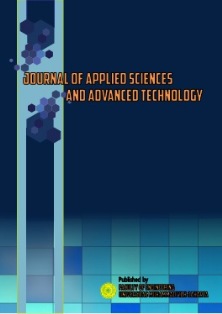Kepok Banana Peel Extract (Musa Paradisiaca) as Antibacterial and Renewable-Biodegradable Surfactant in Liquid Detergent
DOI:
https://doi.org/10.24853/jasat.7.1.25-34Keywords:
Kepok banana, Antibacterial, Surfactant Renewable surfactants, Liquid detergent.Abstract
Kepok banana peel contains tannin as antibacterial activity and saponin acts like a surfactant. Detergent is a cleaning agent commonly used by the community. Banana peel is extracted with ethanol solvent to produce antibacterial activity and can be used as a bioadditive. Knowing the antibacterial activity, the extract requires incubation. Because the nature of saponin is the same as surfactant, banana peel extract can be compared with mes surfactant to make liquid detergent. This study was conducted to identify tannin and saponin in banana peel extract, obtain the best banana peel extract yield with the best solvent concentration and the best incubation time for bacterial inhibition, and the best formulation with the addition of extract to the liquid detergent application. The banana peel extraction process with ethanol uses the Ultrasonic Bath Extraction method. The independent variables in this study were the concentration of extraction solvent (50%, 60%, 70%, 80% and 96%) and the formulation of adding banana peel extract (0%, 5%, 10%, 15% and 20%). The best extraction results were obtained with a solvent concentration of 96% which produced a brown liquid with a strong aroma containing tannins and saponins with the best yield of 11.27% and the best antibacterial activity test with a time of 72 hours, then the extract was made into a liquid detergent formulation as a surfactant and compared with MES surfactant so that the best formulation was obtained in formulation F2 (5% banana peel extract 15% methyl ester sulfonate surfactant) and formulation F3 (10% banana peel extract 10% methyl ester sulfonate surfactant).Downloads
References
Adiwibowo, Muhammad Triyogo, Herayati Herayati, Karen Erlangga, and Dela Ayu Fitria. 2020. “The Effect of Extraction Method and Time on the Quality and Quantity of Saponins in Fruit, Leaf, and Leaf Stalk Extracts of Starfruit (Avverhoa Bilimbi L.) for Detergent Applications.” Journal of Process Integration 9 (2):44.https://doi.org/10.36055/jip.v9i2.9262
Amanatulloh, Shavyta Putri. nd “ANTIBACTERIAL ACTIVITY TEST OF CAVENDISH BANANA PEEL WASTE EXTRACT ON THE GROWTH OF E.Coli BACTERIA,” no. 18: 1–8.
Andika, Bayu, Puji Wahyuningsih, and Rahmatul Fajri. 2020. “Determination of BOD and COD Values as Water Pollution Parameters and Wastewater Quality Standards at the Medan Palm Oil Research Center (PPKS). Quimica: Journal of Science and Applied Chemistry 2 (1): 14–22.https://ejurnalunsam.id/index.php/JQ
Andira Tahir, Sari, and Kata Kunci. 2023. “Optimum Formulation of Liquid Detergent from Hibiscus Flower Extract as Biosurfactant,” no. April: 2017–21.
Anggraini, Deri, Mohamad Gazali, Selvi Mardalena, Ropita Ropita, Farah Salsabila, Irnu Alfarisi, and Rina Syafitri. 2022. “Liquid Detergent Formulation from Sonneratia Alba Fruit Extract.” Indonesian Journal of Fishery Product Processing 25 (3): 528–38.https://doi.org/10.17844/jphpi.v25i3.42835
Ariani, Novia, and Rakhmadhan Niah. 2020. “In Vitro Antibacterial Activity Test of Ethanol Extract of Raw Kepok Banana Peel.” Manuntung Scientific Journal 5 (2): 161–66.https://doi.org/10.51352/jim.v5i2.270
Carretta, Laura, Alessandra Cardinali, Roberta Masin, Giuseppe Zanin, and Harald Cederlund. 2020. “Decyl Glucoside Surfactant Triton CG-110 Does Not Significantly Affect the Environmental Fate of Glyphosate in the Soil at Environmentally Relevant Concentrations.” Journal of Hazardous Materials 388 (January): 122111.https://doi.org/10.1016/j.jhazmat.2020.122111
Conditioner, Air, Devy Setyana, and Moh Yani. 2021. “Formulation of Air Conditioner (AC) Cleaning Liquid Based on Methyl Ester Sulfonate (Mes).” Journal of Agricultural Industrial Technology 31 (2012): 232–41.https://doi.org/10.24961/j.tek.ind.pert.2021.31.2.232
Devianti, VA, L. Sa'diyah, and AR Amalia. 2020. “Determination of Pectin Quality from Banana Peel Waste with Variations in Citric Acid Solvent Volume.” Journal of Chemistry 14 (2): 169.https://doi.org/10.24843/jchem.2020.v14.i02.p10
Do, Dinh Nhat, Tan Tai Dang, Quang Tuan Le, Tri Duc Lam, Long Giang Bach, Duy Chinh Nguyen, and Tran Quoc Toan. 2019. "Extraction of Saponin from Gleditsia Peel and Applications on Natural Dishwashing Liquid Detergent." Materials Today: Proceedings 18: 5219–30.https://doi.org/10.1016/j.matpr.2019.07.522
Handayani, Leni. 2020. “The Effect of Detergent Content in Household Waste on the Survival of Giant Freshwater Prawns (Macrobracium Rosenbergii).” Sebatik 24(1):75–80.https://doi.org/10.46984/sebatik.v24i1.937
Lestari, SR I. 2020. “DETERMINATION OF TOTAL FLAVONOID CONTENT OF ETHANOL EXTRACT OF KEPOK BANANA PEEL (Musa Acuminata x Balbisiana) USING UV-VIS SPECTROPHOTOMETRY METHOD,” 2194087.
Listiana, Lisna, Panji Wahlanto, Susan Sintia Ramadhani, and Rian Ismail. 2022. “Determination of Tannin Content in Juiced and Boiled Mangkokan Leaves (Nothopanax Scutellarium Merr) Using UV-Vis Spectrophotometer.” Pharmacy Genius 1 (1): 62–73.https://doi.org/10.56359/pharmgen.v1i01.15
Makatambah, Venila, Fatimawali Fatimawali, and Gerald Rundengan. 2020. “Analysis of Tannin Compounds and Antibacterial Activity of Betel Fruit Fraction (Piper Betle L) Against Streptococcus Mutans.” MIPA Journal 9 (2): 75. https://doi.org/10.35799/jmuo.9.2.2020.28922
Maranggi, Isma Uly, Bella Rahmasari, Febi Dwi Kania, Fadarina, Yuniar, Indah Purnamasari, and Anerasari Meidinariasty. 2020. “Application of Biosurfactants from Sengon Leaves (Albizia Falcataria) and Papaya Peel (Carica Papaya L.) as Environmentally Friendly Detergents.” Sriwijaya State Polytechnic, Proceedings of the Chemical Engineering Student Seminar 1 (1): 11–19.
Mardiyah, Tati, and Imelda Fajriati. 2022. “Preparation of Dog Saliva Dirt Cleaning Detergent with Variations in Methyl Ester Sulfonate (MES) Surfactant Concentration.” Kaunia: Integration and Interconnection Islam and Science Journal 18 (1): 9–15.https://doi.org/10.14421/kaunia.3122
Nurrosyidah, IH, EN Putrai, ICS Klau, and ... 2023. “Eco-Friendly Detergent Formulation of Ethanol Extract of Soap Nut Seeds (Sapindus Rarak DC) Combination of Decyl Glucoside and Lauryl Glucoside Surfactants.” Camellia : Clinical, Pharmaceutical Analitical and Pharmacy Community Journal 2 (1): 84–91.https://journal.um-surabaya.ac.id/index.php/CAM/article/view/17955
Nurrosyidah, Iif Hanifa, Erica Novia Putri, and Berlian Adi Satria. 2023. “ENVIRONMENTALLY FRIENDLY DETERGENT FORMULATION WITH SIMPLISIA POWDER OF WARU LEAVES (Hibiscus Tilliaceus L.) AND LERAK FRUIT (Sapindus Rarak DC.) AS SURFACTANTS.” Indonesian Journal of Pharmaceutical Research 5 (1): 146–55.https://doi.org/10.33759/jrki.v5i1.346
Okouakoua, Frédéric Yannick, Christian Aimé Kayath, Nicaise Saturnin Mokémiabeka, Varelle Bervanie, Ngala Elenga, Digne Nedjea N, Ndelani Nkalla Lambi, et al. 2024. “Antiseptic Efficacy of A Soap Made from Biosurfactants Isolated from Bacillus and Lactobacillus against Pathogenic Bacteria,” 31–58.https://doi.org/10.4236/aim.2024.141004
Primadiamanti, Annisa, Selvi Marcellia, and Sigit Sukmawan. 2021. “ANTIBACTERIAL ACTIVITY OF ANTISEPTIC GEL PREPARATION FROM ETHANOL EXTRACT OF RAW KEPOK BANANA PEEL (Musa Paradisiaca L.) AGAINST Staphylococcus Aureus AND Staphylococcus Epidermidis BACTERIA.” Journal of Medical and Health Sciences 8 (2): 102–10.https://doi.org/10.33024/jikk.v8i2.4289
Rusdianto, Andrew Setiawan, Fillyvio Nizhomia, Giyarto Giyarto, and Andi Eko Wiyono. 2022. "The Characteristics of Liquid Soap with Varied Additions of Moringa Leaf Extract (Moringa Oleifera L.)." International Journal on Food, Agriculture and Natural Resources 3 (1): 33–39.https://doi.org/10.46676/ij-fanres.v3i1.38
Sakalaty, Evanda Enggelina, Ratri Ariatmi Nugrahani, and Nurul Hidayati Fithriyah. 2024. “Chimica et Natura Acta Antioxidant Inhibition Performance of Miana Leaf Extract (Coleus Scutellarioides (L.) Benth.) At Variations in Extraction Time and as an Additive to Liquid Bath Soap” 12 (1): 1–9.http://jurnal.unpad.ac.id/jcena
Salamah, Siti, Ilham Mufandi, Arida Ayu Krismawati, and Saniyah Humairrah. 2023. “The Ability of Egg Shells as Adsorbents to Improve the Quality Standards of Laundry Wastewater (Detergent Water).” Journal of Chemical Engineering 29 (1): 47–53.https://doi.org/10.36706/jtk.v29i1.1294
Sari, Fatma, Yustinah, Nurul Hidayati Fithriyah, Susanty, and Nisrina Harum. 2022. “The Effect of Extraction Time on Flavonoid Content of Red Guava Leaf Extract (Psidium Guajava L) Using Ultrasonic Extraction Method.” Proceedings of Semnastek 2 (1): 1–6.https://jurnal.umj.ac.id/index.php/semnastek/article/view/14678
Sumadewi, Ni Luh Utari, and Dylla Hanggaeni Dyah Puspaningrum. 2021. “STABILITY OF NATURAL COLOR SUBSTANCES AND TANIN CONTENT FROM ROCK BANANA PLANT CORNERS (Musa Balbisiana).” Journal of Chemistry and Packaging 43 (1): 44.https://doi.org/10.24817/jkk.v43i1.6760
Suryalita. 2019. “Review of Various Types of Bananas and Their Benefits.” Proceedings of the Indonesian Biodiversity National Seminar, 99–101.http://journal.uin-alauddin.ac.id/index.php/psb
Wahyuni, NKDMS, WS Rita, and IARA Asih. 2019. “ANTIBACTERIAL ACTIVITY OF YELLOW KEPOK BANANA PEEL EXTRACT (Musa Paradisiaca L.) AGAINST Staphylococcus Aureus AND Escherichia Coli BACTERIA AND DETERMINATION OF TOTAL FLAVONOIDS AND PHENOLS IN ACTIVE FRACTION.” Journal of Chemistry 13 (1): 9.https://doi.org/10.24843/jchem.2019.v13.i01.p02
Yuliyanti, Mela, Vinsensius Maunia Singgih Husada, Halida Anwar Alzundi Fahrudi, and Widiastuti Agustina Eko Setyowati. 2019. “Quality and Detergency Optimization, Liquid Detergent Preparation, Mahogany Seed Extract (Swietenia Mahagoni).” JKPK (Journal of Chemistry and Chemical Education) 4 (2): 65. https://doi.org/10.20961/jkpk.v4i2.32750
Downloads
Published
Issue
Section
License
COPYRIGHT POLICY
The author(s) of an article published in the Journal of Applied Sciences and Advanced Technology (JASAT) retains ownership of the intellectual property rights in work (s).
PUBLISHING RIGHTS
The author(s) of an article published in the Journal of Applied Sciences and Advanced Technology (JASAT) have unrestricted publication rights. The authors give the Journal of Applied Sciences and Advanced Technology (JASAT) the right to publish the article and designate the Faculty of Engineering Universitas Muhammadiyah Jakarta Publishing as the original publisher of the article.
LICENSING POLICY
JASAT is an open-access journal that follows the Creative Commons Non-Commercial 4.0 International License (CC BY-NC 4.0), which states that:

Under this license, the reusers must give appropriate credit, provide a link to the license, and indicate if changes were made. Users may do so in any reasonable manner, but not in any way that suggests the licensor endorses users or their use.
Please take the time to read the whole license agreement (https://creativecommons.org/licenses/by-nc/4.0/). As long as reusers follow the license conditions, the owner cannot withdraw these freedoms. The following components are included under this license:
 Attribution: Users must provide appropriate attribution, including a link to the license, and indicate whether or not they made any modifications. Users are free to do so reasonably, but not in a manner that indicates the licensee approves of their usage.
Attribution: Users must provide appropriate attribution, including a link to the license, and indicate whether or not they made any modifications. Users are free to do so reasonably, but not in a manner that indicates the licensee approves of their usage.
 NonCommercial: Users may not use the material for commercial purposes.
NonCommercial: Users may not use the material for commercial purposes.












_2.png)


1.png)

2.png)
